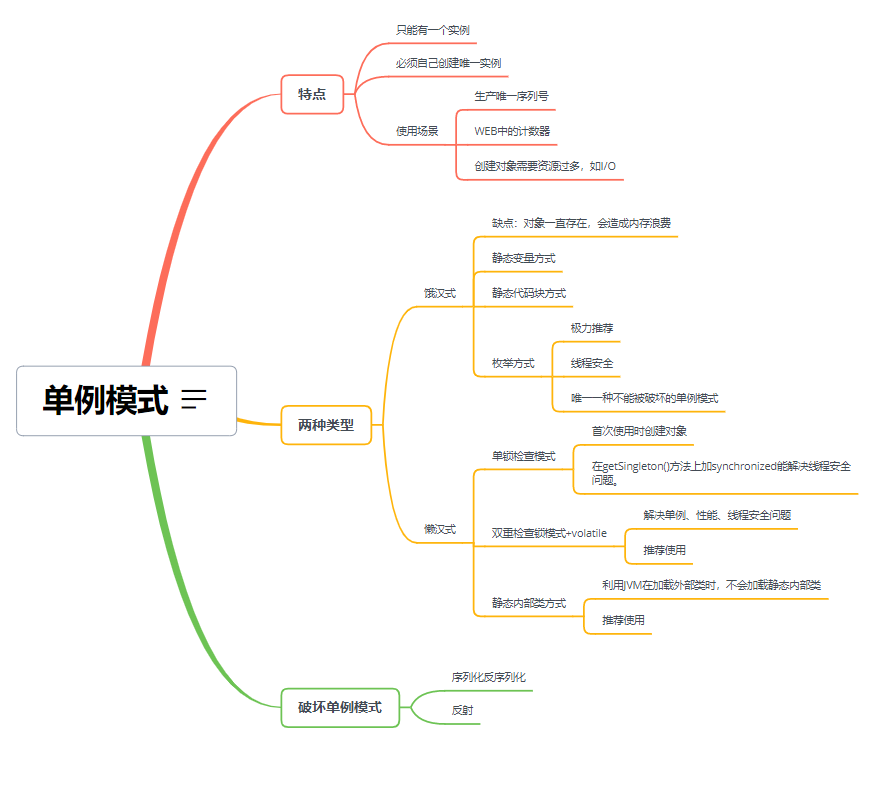前言
本片博客主要记录Java23种设计模式中的创建型模式中的单例模式。单例模式可分为两类,一种是饿汉式,一种是懒汉式。饿汉式的三种设计方式(静态变量方式、静态代码块方式、枚举方式),懒汉式(单锁检查方式、双锁检查方式、静态内部类方式),以及破坏单例模式的两种方式:序列化反序列化,反射。
设计模式,是一套被反复使用、多数人知晓的、经过分类编目的、代码设计经验的总结。使用设计模式是为了可重用代码、让代码更容易被他人理解、保证代码可靠性、程序的重用性

单例模式结构
私有的构造方法【核心】
私有的、静态的实例化变量应用
提供一个公有的、静态的获取类实例对象方法
单例模式
单例模式(Singleton Pattern)是 Java 中最简单的设计模式之一。它提供了一种创建对象的最佳方式。
单例模式涉及到一个单一的类,该类负责创建自己的对象,同时确保只有单个对象被创建。这个类提供了一种访问其唯一的对象的方式,可以直接访问,不需要实例化该类的对象。
1、单例类只能有一个实例。
2、单例类必须自己创建自己的唯一实例。
3、单例类必须给所有其他对象提供这一实例。
饿汉式
静态变量方式
- 直接在创建对象时赋值
复制代码
- 1
- 2
- 3
- 4
- 5
- 6
- 7
- 8
- 9
- 10
- 11
- 12
- 13
- 14
- 15
- 16
- 17
- 18
- 19
- 20
- 21
- 22
- 23
- 24
- 25
- 26
- 27
- 28
- 29
- 30
- 31
- 32
- 33
- 34
- 35
- 36
package hello;
public class Hello {
public static void main(String[] args) {
//只能通过getSingleton方法获取,不能通过new方法创建
Singleton singleton = Singleton.getSingleton();
Singleton singleton11 = Singleton.getSingleton();
//通过hashCode查看是否是同一个对象
System.out.println(singleton.hashCode());
System.out.println(singleton11.hashCode());
}
}
class Singleton{
//私有构造方法,这样外界就不能创建了
private Singleton(){
}
//自己创建一个对象
private static Singleton singleton = new Singleton();
//给外界提供一个方法用于访问
public static Singleton getSingleton(){
return singleton;
}
}
静态代码块方式
- 在静态代码块里赋值
复制代码
- 1
- 2
- 3
- 4
- 5
- 6
- 7
- 8
- 9
- 10
- 11
- 12
- 13
- 14
- 15
- 16
- 17
- 18
- 19
- 20
- 21
- 22
- 23
- 24
- 25
- 26
- 27
- 28
- 29
- 30
- 31
- 32
- 33
- 34
- 35
- 36
package hello;
public class Hello {
public static void main(String[] args) {
//只能通过getSingleton方法获取,不能通过new方法创建
Singleton singleton = Singleton.getSingleton();
Singleton singleton11 = Singleton.getSingleton();
//通过hashCode查看是否是同一个对象
System.out.println(singleton.hashCode());
System.out.println(singleton11.hashCode());
}
}
class Singleton{
//私有构造方法,这样外界就不能创建了
private Singleton(){
}
//自己创建一个对象,但是不实例
private static Singleton singleton;
//通过静态代码块赋值
static {
singleton = new Singleton();
}
//给外界提供一个方法用于访问
public static Singleton getSingleton(){
return singleton;
}
}
枚举方式
由于上面检测代码相同,就不在这里重复复制了。
只需要把class Singleton改为下面就行了
复制代码
- 1
- 2
- 3
enum Singleton{
SINGLETON;
}
懒汉式
单锁检查模式
复制代码
- 1
- 2
- 3
- 4
- 5
- 6
- 7
- 8
- 9
- 10
- 11
- 12
- 13
- 14
- 15
- 16
- 17
- 18
- 19
- 20
- 21
- 22
- 23
- 24
- 25
- 26
- 27
- 28
- 29
- 30
- 31
- 32
- 33
- 34
- 35
package hello;
public class Hello {
public static void main(String[] args) {
Singleton singleton = Singleton.getSingleton();
Singleton singleton11 = Singleton.getSingleton();
//通过hashCode查看是否是同一个对象
System.out.println(singleton.hashCode());
System.out.println(singleton11.hashCode());
}
}
class Singleton{
//私有构造方法,这样外界就不能创建了
private Singleton(){ }
//自己声明一个对象
private static Singleton singleton;
//给外界提供一个方法用于访问
public static synchronized Singleton getSingleton(){
//判读singleton是否为null,如果是null就创建,否者直接返回
if (singleton == null){
singleton = new Singleton();
}
return singleton;
}
}
双重检查锁模式
上面的验证都是一样的,这里只显示Singleton类就行
复制代码
- 1
- 2
- 3
- 4
- 5
- 6
- 7
- 8
- 9
- 10
- 11
- 12
- 13
- 14
- 15
- 16
- 17
- 18
- 19
- 20
- 21
- 22
class Singleton{
//私有构造方法,这样外界就不能创建了
private Singleton(){ }
//自己声明一个对象
private static volatile Singleton singleton;
//给外界提供一个方法用于访问
public static synchronized Singleton getSingleton(){
//判读singleton是否为null,如果是null就创建,否者直接返回
if (singleton == null){
synchronized (Singleton.class){
if (singleton == null){
singleton = new Singleton();
}
}
}
return singleton;
}
}
静态内部类实现
-
静态内部类单例模式是一种优秀的单例模式,是比较常用的单例模式。在没有加任何锁时保证线程安全,并且没有任何性能影响和空间浪费。
-
在加载Singleton时不会初始化singleton,只有第一次调用getSingleton()时。JVM加载SingletonHolder初始化singleton。
复制代码
- 1
- 2
- 3
- 4
- 5
- 6
- 7
- 8
- 9
- 10
- 11
- 12
- 13
- 14
- 15
- 16
class Singleton{
//私有构造方法,这样外界就不能创建了
private Singleton(){ }
//定义一个静态内部类
private static class SingletonHolder{
//只会初始化一次
private static final Singleton singleton= new Singleton();
}
//给外界提供一个方法用于访问
public static synchronized Singleton getSingleton(){
return SingletonHolder.singleton;
}
}
破坏单例模式
- 破坏单例模式的方式有两种一种是序列化反序列化,另一种是反射,这里我们指记录反射
- 道高一尺,魔高一丈。有模式就会有破坏,有破坏还会有防破坏,但是还有反反破坏。这里面就多了。
通过反射破坏单例模式
复制代码
- 1
- 2
- 3
- 4
- 5
- 6
- 7
- 8
- 9
- 10
- 11
- 12
- 13
- 14
- 15
- 16
- 17
- 18
- 19
- 20
- 21
- 22
- 23
- 24
- 25
- 26
- 27
- 28
- 29
- 30
- 31
- 32
- 33
- 34
- 35
- 36
- 37
- 38
- 39
- 40
- 41
- 42
package hello;
import java.lang.reflect.Constructor;
import java.lang.reflect.InvocationTargetException;
public class Hello {
public static void main(String[] args) throws NoSuchMethodException, IllegalAccessException, InvocationTargetException, InstantiationException {
//获取Singleton字节码对象
Class<Singleton> singletonClass = Singleton.class;
//获取无参构造方法
Constructor<Singleton> declaredConstructor = singletonClass.getDeclaredConstructor();
//取消访问检查
declaredConstructor.setAccessible(true);
//创建Singleton对象
Singleton singleton = (Singleton) declaredConstructor.newInstance();
Singleton singleton1 = (Singleton) declaredConstructor.newInstance();
//通过hashCode查看是否是同一个对象
System.out.println(singleton.hashCode());
System.out.println(singleton1.hashCode());
}
}
class Singleton{
//私有构造方法,这样外界就不能创建了
private Singleton(){ }
//定义一个静态内部类
private static class SingletonHolder{
//只会初始化一次
private static final Singleton singleton= new Singleton();
}
//给外界提供一个方法用于访问
public static synchronized Singleton getSingleton(){
return SingletonHolder.singleton;
}
}
单例模式优缺点
优点:
- 单例模式在内存中只有一个实例,减少内存开支,特别是一个对象需要频繁地创建销毁时,而且创建或销毁时性能又无法优化,单例模式就非常明显了
- 单例模式只生成一个实例,减少系统的性能开销
- 单例模式可以避免对资源的多重占用
- 单例模式可以在系统设置全局的访问点,优化和共享资源访问
缺点: - 不适用于变化的对象
- 由于单例模式没有抽象层,所以扩展困难
- 单例类的职责过重,在一定程度上违背了“单一职责原则”
- 单一职责原则:一个类,应该只有一个职责